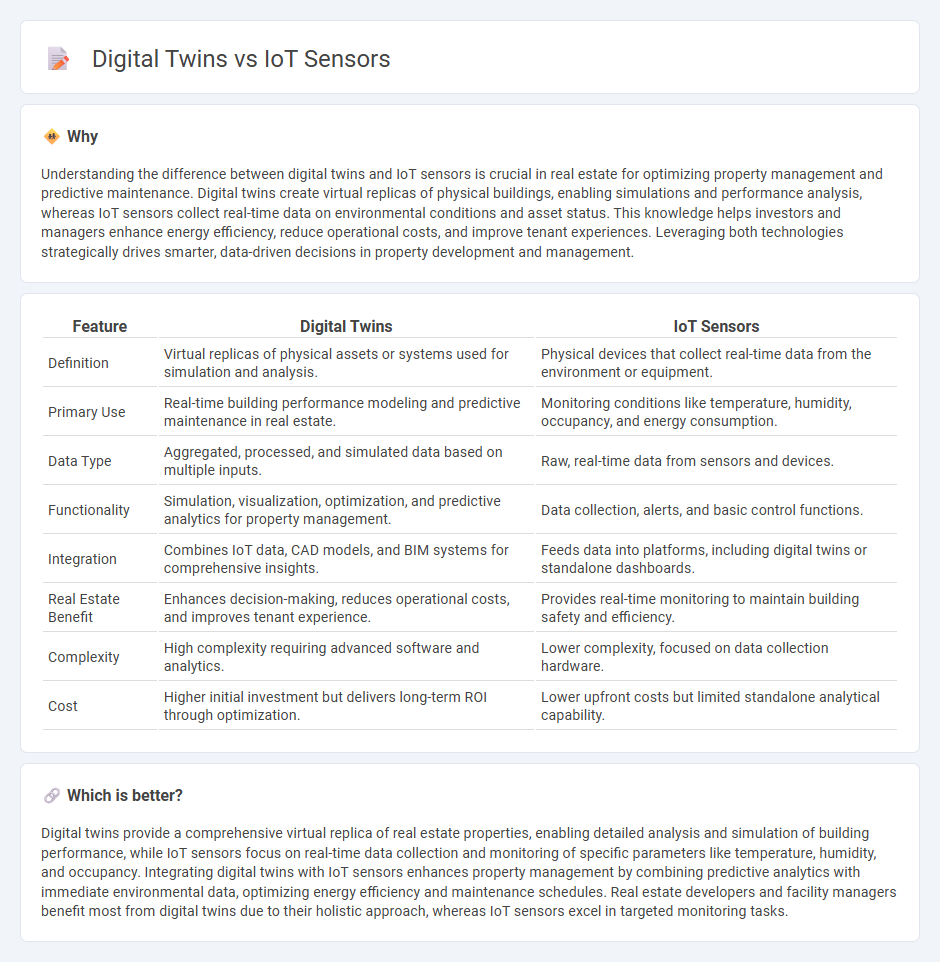
Digital twins create detailed virtual replicas of physical real estate assets to monitor, simulate, and optimize building performance and maintenance throughout their lifecycle. IoT sensors collect real-time data on temperature, humidity, occupancy, and energy usage, enabling proactive management and enhancing automation in smart buildings. Explore how integrating digital twins and IoT sensors transforms property management and decision-making in the real estate industry.
Why it is important
Understanding the difference between digital twins and IoT sensors is crucial in real estate for optimizing property management and predictive maintenance. Digital twins create virtual replicas of physical buildings, enabling simulations and performance analysis, whereas IoT sensors collect real-time data on environmental conditions and asset status. This knowledge helps investors and managers enhance energy efficiency, reduce operational costs, and improve tenant experiences. Leveraging both technologies strategically drives smarter, data-driven decisions in property development and management.
Comparison Table
| Feature | Digital Twins | IoT Sensors |
|---|---|---|
| Definition | Virtual replicas of physical assets or systems used for simulation and analysis. | Physical devices that collect real-time data from the environment or equipment. |
| Primary Use | Real-time building performance modeling and predictive maintenance in real estate. | Monitoring conditions like temperature, humidity, occupancy, and energy consumption. |
| Data Type | Aggregated, processed, and simulated data based on multiple inputs. | Raw, real-time data from sensors and devices. |
| Functionality | Simulation, visualization, optimization, and predictive analytics for property management. | Data collection, alerts, and basic control functions. |
| Integration | Combines IoT data, CAD models, and BIM systems for comprehensive insights. | Feeds data into platforms, including digital twins or standalone dashboards. |
| Real Estate Benefit | Enhances decision-making, reduces operational costs, and improves tenant experience. | Provides real-time monitoring to maintain building safety and efficiency. |
| Complexity | High complexity requiring advanced software and analytics. | Lower complexity, focused on data collection hardware. |
| Cost | Higher initial investment but delivers long-term ROI through optimization. | Lower upfront costs but limited standalone analytical capability. |
Which is better?
Digital twins provide a comprehensive virtual replica of real estate properties, enabling detailed analysis and simulation of building performance, while IoT sensors focus on real-time data collection and monitoring of specific parameters like temperature, humidity, and occupancy. Integrating digital twins with IoT sensors enhances property management by combining predictive analytics with immediate environmental data, optimizing energy efficiency and maintenance schedules. Real estate developers and facility managers benefit most from digital twins due to their holistic approach, whereas IoT sensors excel in targeted monitoring tasks.
Connection
Digital twins in real estate create precise virtual models of physical properties by integrating real-time data from IoT sensors embedded in buildings. These sensors monitor structural health, energy usage, and occupancy patterns, enabling dynamic simulations and predictive maintenance. The synergy of digital twins and IoT enhances property management efficiency, reduces operational costs, and improves asset lifecycle management.
Key Terms
Data Collection
IoT sensors gather real-time data from physical environments, capturing temperature, humidity, motion, and other metrics essential for monitoring and control. Digital twins utilize this data to create accurate virtual replicas of physical assets, enabling simulation, predictive analysis, and optimized decision-making processes. Explore how integrating IoT sensors with digital twins enhances data collection accuracy and operational efficiency.
Virtual Representation
IoT sensors provide real-time data by capturing physical conditions such as temperature, humidity, and motion, enabling accurate monitoring and control of assets. Digital twins leverage this IoT data to create dynamic virtual representations of physical objects or systems, allowing simulation, analysis, and predictive maintenance. Explore in-depth how integrating IoT sensors with digital twins enhances operational efficiency and decision-making.
Predictive Maintenance
IoT sensors collect real-time data on equipment conditions, enabling precise monitoring for predictive maintenance through early detection of anomalies. Digital twins utilize this IoT data to create virtual replicas of physical assets, simulating performance and forecasting potential failures with higher accuracy. Explore how integrating IoT sensors and digital twins can revolutionize your predictive maintenance strategy.
Source and External Links
Top 10 IoT Sensor Types, Use Cases, and Examples - This article provides insights into various IoT sensor types, including temperature, humidity, and motion sensors, and their applications in different industries.
16 Types of IoT Sensors - This article lists and describes different types of IoT sensors such as accelerometers, air quality sensors, and chemical sensors, highlighting their role in gathering real-time data.
16 Types of sensors used in IoT - This resource covers various IoT sensors, their functionalities, and how they are used to sense and transmit data about environmental conditions in IoT applications.
 dowidth.com
dowidth.com